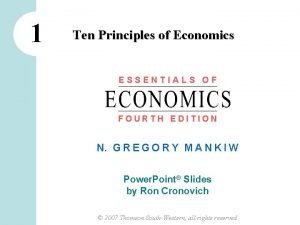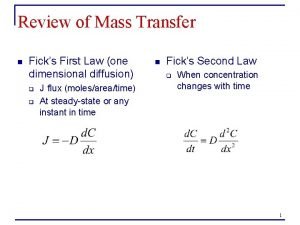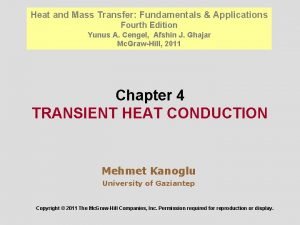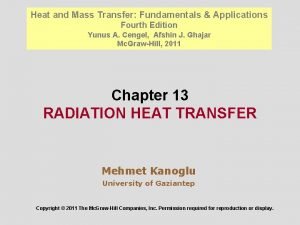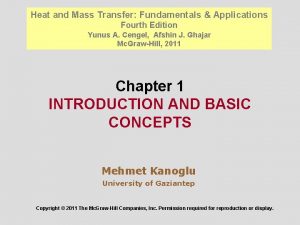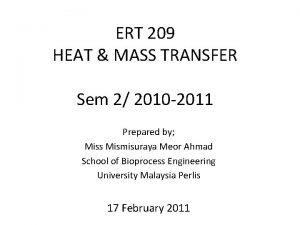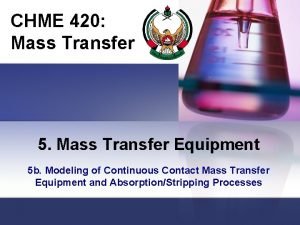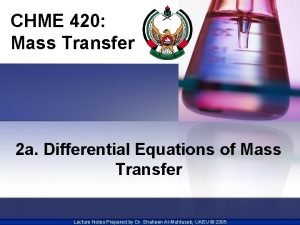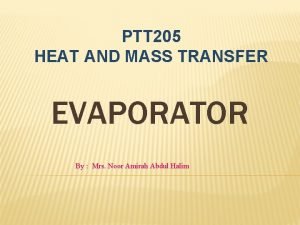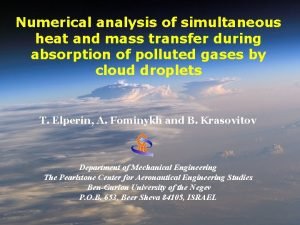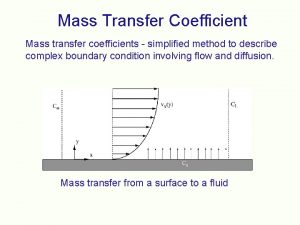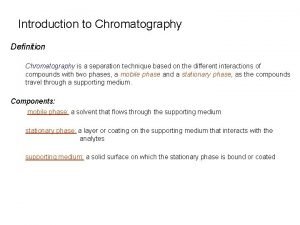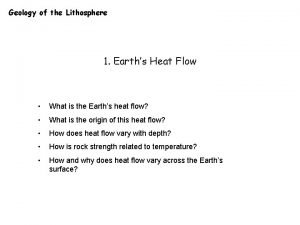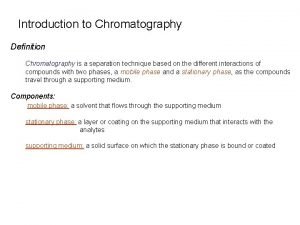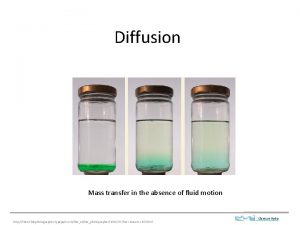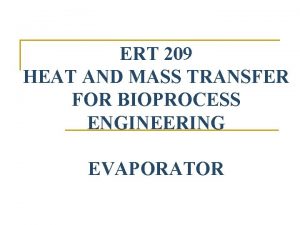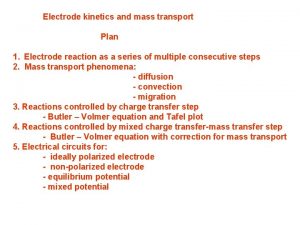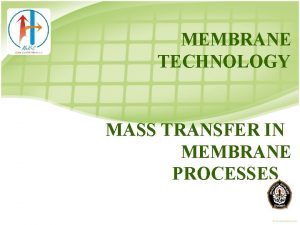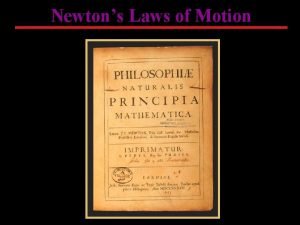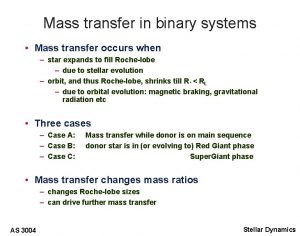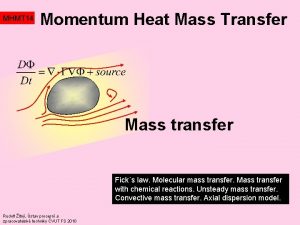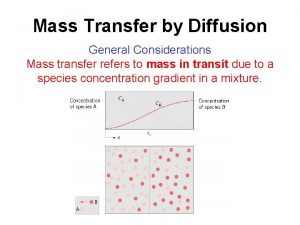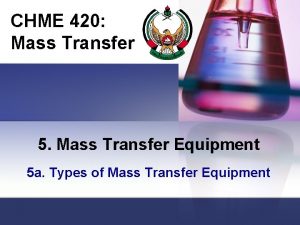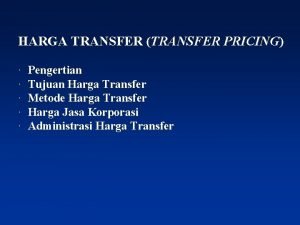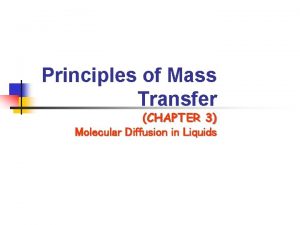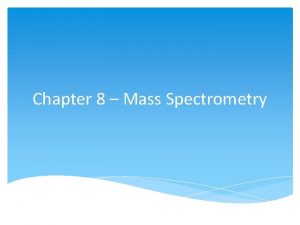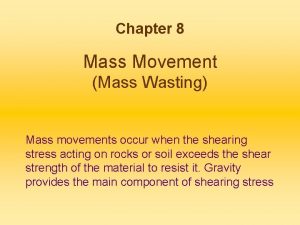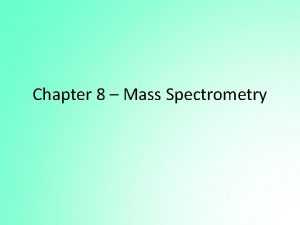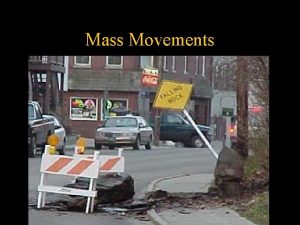CHAPTER ONE Principles of Mass Transfer 1 Mass














































- Slides: 46

CHAPTER ONE Principles of Mass Transfer 1

Mass Transfer Gases Molecular Diffusion Chapter 6 Convective Mass Transfer Chapter 7 Liquid Solid 2

Introduction l Mass transfer occurs when a component in a mixture migrates in the same phase or from phase to phase because of a different in concentration between two point. l Somewhat similar to heat conduction, but in conduction the medium is stationary and only energy in the form of heat is being transferred. l Example of mass transfer 1. Evaporation of water in the open pail to the atmosphere 2. Coffee dissolve in water 3. Oxygen dissolved in the solution to the microorganism in the fermentation process l Possible driving force for mass transfer 1. Concentration different 2. Pressure different 3. Electrical gradient, etc 3

Type of Mass Transfer 1. Molecular diffusion Ø Transfer of individual molecules through a fluid by random movement from high concentration to low concentration Ø E. g. coffee dissolve in water in making coffee 2. Convective mass transfer Ø Using mechanical force or action to increase the rate of molecular diffusion Ø E, g stirred the water to dissolve coffee during coffee making 4

Molecular Diffusion l Diffusion of molecules when the bulk fluid is stationary given by Fick’s law c : total conc. of A and B (kgmol A+B/ m 3) x. A : mole fraction of A DAB : molecular diffusivity of A in B (m 2/s) l If total conc. , c is constant and c. A=x. Ac, then: 5

Convection Mass Transfer l When a fluid flowing outside a solid surface in forced convection motion, rate of convective mass transfer is given by: kc c. L 1 c. Li : mass transfer coefficient (m/s) : bulk fluid conc. : conc. of fluid near the solid surface l kc depend on: 1. System geometry 2. Fluid properties 3. Flow velocity 6

Molecular Diffusion in Gases Mass Transfer Gases Molecular Diffusion Chapter 6 Convective Mass Transfer Chapter 7 Liquid Solid 7

Contents: 1. Introduction 2. Equimolar counter diffusion 3. Diffusion of gases A and B plus convection 4. Gas A diffusing through stagnant, non-diffusing B 5. Diffusion through varying cross sectional area 6. Diffusion coefficient for gases 8

Fick’s Law for Gases l Molecular diffusion from c. A 1 to c. A 2 from z 1 to z 2 l For ideal gas PV=n. RT, where c=n/V=P/RT 9

Equimolar Counter Diffusion PA 1 > PA 2 PB 2 > PB 1 Fig. 6. 2 -1 10

EXAMPLE 6. 2 -1. Equimolar Counterdiffusion Ammonia gas (A) is diffusing through a uniform tube 0. 10 m long containing N 2 gas (B) at 1. 0132 x 105 Pa pressure and 298 K. The diagram is similar to Fig. 6. 2 -1 in lecture. At point 1, p. A 1 = 1. 013 x 104 Pa and at point 2, p. A 2 = 0. 507 x 104 Pa. The diffusivity DAB = 0. 230 x 10 -4 m 2/s. Calculate the flux at steady state. Repeat for Solution: Equation (6. 1 -13) can be used, where P = 1. 0132 x 105 Pa, z 2 - z 1 = 0. 10 m, and T = 298 K. Substituting into Eq. (6. 1 -13) for part (a), Rewriting Eq. (6. 1 -13) for component B for part (b) and noting that p. B 1 = P - p. A 1 = 1. 0132 x 105 - 1. 013 x 104 = 9. 119 x 104 Pa and p. B 2 = P - p. A 2 = 1. 0132 x 105 - 0. 507 x 104 = 9. 625 x 104 Pa, The negative value for means the flux goes from point 2 to point 1 11

Diffusion of Gases A and B Plus Convection 1/2 v. Ad vm v. A = velocity of A relative to stationary point v. Ad = diffusion of A relative to moving fluid vm = molar average velocity of whole fluid or convective velocity v. A = v. Ad + vm Multiply by c. Av. A= c. Av. Ad + c. Avm c. Av. A = NA = total flux of A relative to stationary point c. Av. Ad= JA*= diffusion flux relative to moving fluid c. Avm = convective flux of A relative to stationary point NA= JA* + c. Avm 12

Diffusion of Gases A and B Plus Convection 2/2 l Let N is total convective flux of the whole stream relative to stationary point; N=NA + NB = cvm or vm = (NA + NB) / c General equation become: or or If counter diffusion, the convective term become zero; NA = JA* 13

Gas A Diffusing Through Stagnant, Nondiffusing B 1/2 l One boundary at the end of the diffusion path is impermeable to component B ( NB=0) Ø Evaporation of pure liquid such as benzene (A) at the bottom of narrow tube , where a large amount of air (B) passed over the top Ø Benzene vapor (A) diffuse through the air (B) in the tube Ø But at point 1, air (B) is insoluble in liquid benzene (NB=0) Ø Also at point 2, p. A 2=0 since a large volume of air is passing through Ø Absorption of NH 3 (A) by water, which NH 3 contain in air (B) Ø Water surface is impermeable to air (B) (NB=0) but NH 3 can dissolve in water 14

Gas A Diffusing Through Stagnant, Non-diffusing B 2/2 l General equation l Another form to write the eq is using p. BM; also we know that P = p. A 1 + p. B 1= p. A 2 + p. B 2 Time for evaporation 15

EXAMPLE 6. 2 -2. 1/2 Diffusion of Water Through Stagnant, Nondiffusing Air Water in the bottom of a narrow metal tube is held at a constant temperature of 293 K. The total pressure of air (assumed dry) is 1. 01325 x 105 Pa (1. 0 atm) and the temperature is 293 K (20°C). Water evaporates and diffuses through the air in the tube, and the diffusion path z 2 - z 1 is 0. 1524 m (0. 5 ft) long. The diagram is similar to Fig. 6. 2 -2 a. Calculate the rate of evaporation at steady state in lb mol/h · ft 2 and kg mol/s · m 2. The diffusivity of water vapor at 293 K and 1 atm pressure is 0. 250 x 10 -4 m 2/s. Assume that the system is isothermal. Use SI and English units. Solution: The diffusivity is converted to ft 2/h by using the conversion factor from Appendix A. 1: From Appendix A. 2 the vapor pressure of water at 20°C is 17. 54 mm Hg , or p. A 1 = 17. 54/760 = 0. 0231 atm = 0. 0231(1. 01325 x 105) = 2. 341 x 103 Pa p. A 2 = 0 (pure air). 16

EXAMPLE 6. 2 -2. 2/2 Since the temperature is 20°C (68°F), T = 460 + 68 = 528°R = 293 K. From Appendix A. 1, R = 0. 730 ft 3 · atm/lb · mol·°R. To calculate the value of p. BM from Eq. (6. 2 -21), Since p. B 1 is close to p. B 2, the linear mean (p. B 1 + p. B 2)/2 could be used and would be very close to p. BM. Substituting into Eq. (6. 2 -22) with z 2 - z 1 = 0. 5 ft (0. 1524 m), 17

Diffusion Through Varying Cross Sectional Area Diffusion from a sphere l Example ¡ Evaporation of a drop of liquid ¡ Evaporation of ball of naphthalene Diffusion rate (kgmol/s) l Simplified eq. if (p. A 1<<P; p. BM≈P; 2 r 1=D 1; c. A 1=p. A 1/RT) l Time for evaporation 18

Diffusion Coefficient for Gases 1/2 Empirical equation for DAB 1. Chapman& Enskog P = absolute pressure in atm σAB = average collision diameter ΩD, AB = collision integral based on Lennard-Jones potential; is a ratio giving the deviation of a gas with interaction as compared to a gas 19 rigid, elastic spheres.

Diffusion Coefficient for Gases 2/2 2. Fuller et al. Equation 6. 2 -45 T, in K, P in atm, n in m 3 Use atomic diffusion volume (n) from Table 6. 2 -2. 20

21

Table 6. 2 -2 22

EXAMPLE 6. 2 -5. Estimation of Diffusivity of a Gas Mixture Normal butanol (A) is diffusing through air (B) at 1 atm abs. Using the Fuller et al. method, estimate the diffusivity DAB for the following temperatures and compare with the experimental data: a) For 0°C. b)For 25. 9°C. c) For 0°C and 2. 0 atm abs. Solution: For part (a), P = 1. 00 atm, T = 273 + 0 = 273 K, MA(butanol) = 74. 1, MB(air) = 29. From Table 6. 2 -2, Substituting into Eq. (6. 2 -45), This value deviates by +10% from the experimental value of 7. 03 x 10 -6 m 2/s from Table 6. 2 -1. For part (b), T = 273 + 25. 9 = 298. 9. Substituting into Eq. (6. 2 -45), DAB = 9. 05 x 10 -6 m 2/s. This value deviates by +4% from the experimental value of 8. 70 x 10 -6 m 2/s. For part (c), the total pressure P = 2. 0 atm. Using the value predicted in part (a) and correcting for pressure, 23

Molecular Diffusion in Liquids Mass Transfer Gases Molecular Diffusion Chapter 6 Convective Mass Transfer Chapter 7 Liquid Solid 24

Introduction l Typical phenomena of molecular diffusion in liquids Ø Liquid-liquid extraction Ø Gas absorption Ø Diffusion of salts in blood Ø Oxygenation of river, and etc l Molecular diffusion in liquid is smaller than molecular diffusion in gases ¡ Reason: molecules in liquid are close together compared to molecules in gases; molecules of diffusing solute will collide more frequently with liquid molecules l Diffusivity in liquid dependent on the concentration of diffusing solute. 25

Equimolar Counter Diffusion l Concentration is not constant, take average concentration, cav 1 and 2 represent a position/point M – average molecular weight 26

Average Molecular Weight Recall for average molecular weight: yi – mole fraction xi – mass fraction Don’t confuse about the symbol use for determine ave Mw. Using above eq. x. A is for mass fraction and y. A is for mole fraction. 27 However, for previous molecular diffusion, x. A is stand for mole fraction.

Diffusion of A through Nondiffusing B l Example: Ø Dilute solution of propionic acid (A) in a water (B) solution being contact with toluene Ø Only propionic acid (A) diffuses through the water phase, to the boundary and then into the toluene phase Ø Water (B) cannot diffuse in toluene-water interface 28

EXAMPLE 6. 3 -1. Diffusion of Ethanol (A) Through Water (B) 1/2 An ethanol (A)–water (B) solution in the form of a stagnant film 2. 0 mm thick at 293 K is in contact at one surface with an organic solvent in which ethanol is soluble and water is insoluble. Hence, NB = 0. At point 1 the concentration of ethanol is 16. 8 wt % and the solution density is ρ1 = 972. 8 kg/m 3. At point 2 the concentration of ethanol is 6. 8 wt % and ρ2 = 988. 1 kg/m 3. The diffusivity of ethanol is 0. 740 x 10 -9 m 2/s. Calculate the steady-state flux NA. Solution: The diffusivity is DAB = 0. 740 x 10 -9 m 2/s. The molecular weights of A and B are MA = 46. 05 and MB = 18. 02. For a wt % of 6. 8, the mole fraction of ethanol (A) is as follows when using 100 kg of solution: Then x. B 2 = 1 - 0. 0277 = 0. 9723. Calculating x. A 1 in a similar manner, x. A 1 = 0. 0732 and x. B 1 = 1 - 0. 0732 = 0. 9268. To calculate the molecular weight M 2 at point 2, 29

EXAMPLE 6. 3 -12/2 l Similarly, M 1 = 20. 07. l From Eq. (6. 3 -2), l To calculate x. BM from Eq. (6. 3 -4), we can use the linear mean since x. B 1 and x. B 2 are close to each other: l Substituting into Eq. (6. 3 -3) and solving, 30

Diffusivity in Liquids 1. Experimental determination of diffusivity 2. Experimental liquid diffusivity data (Table 6. 3 -1) 3. Predictian of diffusivity in liquids a) Stokes- Einstein equation B) Wilke-Chang equation 31

Table 6. 3 -1. Diffusion Coefficients for Dilute Liquid Solutions l 32

Stokes- Einstein Equation This equation holds for: -molecule with MW >1000 -molar vol ~ 0. 5 m 3/kg mol T- temperature in Kelvin VA- solute molar volume at normal boiling point (m 3/kgmol) Table 6. 3 -2 m- viscosity of solution in Pa · s or kg/m · s DAB- Diffusion Coefficient in m 2/s 33

Table 6. 3 -2 34

Wilke-Chang Equation l Solute A is dilute in the solvent B l Limited to VA (solute molar volume ) < 0. 5 m 3/kgmol l If solute A is water, multiply the equation by (1/2. 3) where m. B is in Pa. s, T in K, DAB in m 2/s l Value for association parameter, Φ Water = 2. 6 Benzene = 1. 0 Me. OH = 1. 9 Ether = 1. 0 Et. OH = 1. 5 Heptane = 1. 0 35

EXAMPLE 6. 3 -2. Prediction of Liquid Diffusivity Predict the diffusion coefficient of acetone (CH 3 COCH 3) in water at 25° and 50°C using the Wilke–Chang equation. The experimental value is 1. 28 x 10 -9 m 2/s at 25°C (298 K). Solution: From Appendix A. 2 the viscosity of water at 25. 0°C is μB = 0. 8937 x 10 -3 Pas and at 50°C, 0. 5494 x 10 -3. From Table 6. 3 -2 for CH 3 COCH 3 with 3 carbons + 6 hydrogens + 1 oxygen, For water the association parameter φ = 2. 6 and MB = 18. 02 kg mass/kg mol. For 25°C, T = 298 K. Substituting into Eq. (6. 3 -9), For 50°C or T = 323 K, 36

Molecular Diffusion in Solids Mass Transfer Gases Molecular Diffusion Chapter 6 Convective Mass Transfer Chapter 7 Liquid Solid 37

Introduction l Diffusion of solute in solid is slower than diffusion of solute in liquid and gases l Example application: Ø Leaching of food Ø Drying of timber, salt, food, etc. Ø Catalytic reaction in solid catalyst Ø Separation of fluid by membrane l Diffusion solute in solids can be categorized into two group 1. Diffusion which follow Fick’s law and does not depend on the actual structure of the solid 2. Diffusion in porous solids which is depend on the actual structure and void structure of the solid 38

Diffusion in Solids which Follow Fick’s Law and Does Not Depend on The Structure of Solids 1/4 l Diffusion occur when the fluid or solute diffusing dissolve in the solid to form a more or less homogeneous solution Diffusion in Solid General Equation Neglect convective term and assume constant concentration DAB ≠ DBA Slab Solid Cylinder Wall r 1: inner radius r 2: outer radius 39 (diffusion radially through a cylinder wall of inner radius r 1 and outer r 2 and length L, )

Diffusion in Solids which Follow Fick’s Law and Does Not Depend on The Structure of Solids 2/4 l Sometimes flux can be expressed in term of solubility (S) S= m 3 (STP) /m 3 solid. atm SI units S= cm 3 (STP) /cm 3 solid. atm cgs units l Relation between solubility and concentration SI unit cgs unit Equation for flux: (SI unit), (PA in atm) 40

Diffusion in Solids which Follow Fick’s Law and Does Not Depend on The Structure of Solids 3/4 l Many data in literature do not determine NA in term of the value of DAB and S , but more often in term of permeability, PM l Then the flux is expressed as: l Several unit for PM in literature PM = DABS PM=10 -4 P’M PM=7. 60 x 10 -4 P’’M PM=m 3(STP)/(s. m 2. atm/m) SI unit P’M= cm 3(STP)/(s. cm 2. atm/cm) cgs unit P”M= cm 3(STP)/(s. cm 2. cm. Hg/mm) 41

Diffusion in Solids which Follow Fick’s Law and Does Not Depend on The Structure of Solids 4/4 l When several layer solid 1, 2, 3…. . in series and L 1, L 2, L 3…represent thickness, flux for diffusion in solid is: 42

EXAMPLE 6. 5 -1. Diffusion of H 2 Through Neoprene Membrane The gas hydrogen at 17°C and 0. 010 atm partial pressure is diffusing through a membrane of vulcanized neoprene rubber 0. 5 mm thick. The pressure of H 2 on the other side of the neoprene is zero. Calculate the steady-state flux, assuming that the only resistance to diffusion is in the membrane. The solubility S of H 2 gas in neoprene at 17°C is 0. 051 m 3 (at STP of 0°C and 1 atm)/m 3 solid · atm and the diffusivity DAB is 1. 03 x 10 -10 m 2/s at 17°C. Solution: A sketch showing the concentration is shown in Fig. 6. 5 -1. The equilibrium concentration c. A 1 at the inside surface of the rubber is, from Eq. (6. 5 -5), Figure 6. 5 -1. Concentrations for Example 6. 5 -1. Since p. A 2 at the other side is 0, c. A 2 = 0. Substituting into Eq. (6. 5 -2) and solving, 43

EXAMPLE 6. 5 -2. Diffusion Through a Packaging Film Using Permeability A polyethylene film 0. 00015 m (0. 15 mm) thick is being considered for use in packaging a pharmaceutical product at 30°C. If the partial pressure of O 2 outside the package is 0. 21 atm and inside it is 0. 01 atm, calculate the diffusion flux of O 2 at steady state. Use permeability data from Table 6. 5 -1. Assume that the resistances to diffusion outside the film and inside are negligible compared to the resistance of the film. Solution: From Table 6. 5 -1, PM=4. 17(10 -12) m 3 solute(STP)/(s·m 2· atm/m). Substituting into Eq. (6. 5 -8), Note that a film made of nylon has a much smaller value of permeability PM for O 2 and would make a more suitable barrier. 44

Table 6. 5 -1 45

Diffusion in Porous Solids that Depend on the Structure l Concerned about the porous solid that have pores or interconnected void in solid which will affect the diffusion Diffusion in Porous Solids Diffusion of Liquid Diffusion of Gases ε –void fraction; ; DA, eff=(ε DAB/ τ)=effective diffusivity τ –tortuosity (a factor which corrects for the path longer than (z 2 - z 1) ) 46
 Disturbance that transfers energy
Disturbance that transfers energy One god one empire one religion
One god one empire one religion One one little dog run
One one little dog run One king one law one faith
One king one law one faith Byzantine definition
Byzantine definition One ford
One ford See one do one teach one
See one do one teach one One price policy
One price policy Willow cabin speech
Willow cabin speech Studiendekanat uni bonn
Studiendekanat uni bonn One vision one identity one community
One vision one identity one community One vision one identity one community
One vision one identity one community Ten principles of economics chapter 1
Ten principles of economics chapter 1 One of the ten principles of economics in chapter 1
One of the ten principles of economics in chapter 1 Forms of government chapter 1 section 2
Forms of government chapter 1 section 2 Principles of reliable data transfer in transport layer
Principles of reliable data transfer in transport layer Reliable data transfer
Reliable data transfer Fick's 2nd law of diffusion
Fick's 2nd law of diffusion Mass transfer coefficient units
Mass transfer coefficient units Heat and mass transfer
Heat and mass transfer Define radiation shield
Define radiation shield Heat and mass transfer fundamentals and applications
Heat and mass transfer fundamentals and applications Heat and mass transfer
Heat and mass transfer Mass transfer equipment
Mass transfer equipment General differential equation for mass transfer
General differential equation for mass transfer Mass transfer coefficient units
Mass transfer coefficient units Heat transfer in evaporator formula
Heat transfer in evaporator formula Simultaneous heat and mass transfer
Simultaneous heat and mass transfer Mass transport
Mass transport Stagnant mobile phase mass transfer
Stagnant mobile phase mass transfer Heat-mass transfer and geodynamics of the lithosphere:
Heat-mass transfer and geodynamics of the lithosphere: Definition of chromatography
Definition of chromatography Plate type exchanger
Plate type exchanger Mass transfer
Mass transfer Mass transfer in bioprocess
Mass transfer in bioprocess Mass transfer in bioprocess
Mass transfer in bioprocess Mass transfer
Mass transfer Mass transfer technology
Mass transfer technology Introduction to mass transfer
Introduction to mass transfer Thermal resistance formula
Thermal resistance formula Mass to mass formula
Mass to mass formula Isotopic mass formula
Isotopic mass formula Relative formula mass of hcl
Relative formula mass of hcl Propane
Propane Inertial mass vs gravitational mass
Inertial mass vs gravitational mass Grams to mole
Grams to mole Unit of molar mass
Unit of molar mass













